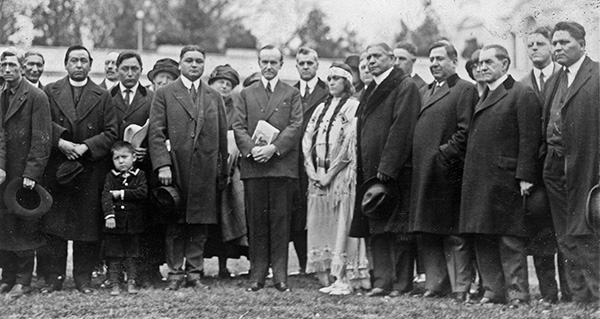Native communities continued to struggle for their right to exist as distinct peoples through the late 1920s and early 1930s. The number of new allotments declined, but supplementary legislation and all manner of dubious dealings at the grassroots level ensured that the divesting of the tribal estate persisted.1 By 1934, less than fifty years after passage of the General Allotment Act, the federal government had liquidated nearly 100 million acres of tribal lands. Compressed into one solid mass, the remaining 48 million acres scattered across Native America would have fit within the boundaries of the state of South Dakota with room to spare. Meanwhile, missionaries were still at play in the fields of the lord, and the Office of Indian Affairs issued circulars outlawing dances, giveaways, and other ceremonial practices. In classic colonial fashion, externally imposed institutions within tribal communities, such as Indian police forces and Courts of Indian Offenses, empowered some Indian people to control and punish others.2
Controversies over land claims, treaty rights, and ceremonial practices, along with worsening conditions on reservations and gross administrative mismanagement, entered the public sphere in the 1920s. Heightened awareness of this dire situation translated into a reevaluation of federal-Indian relations in the form of the Committee of 100 on Indian Affairs in 1923, staffed by several Society of American Indians members, and the Meriam Report, an exhaustive survey of all aspects of the federal government’s administration of Indian affairs published in 1928. While neither of these investigations advocated for the abandonment of allotment or assimilation, they did intersect with ongoing grassroots rights movements throughout Indian Country. In so doing, they contributed to major reforms during the 1930s.3
Catalyzed by the onset of the Great Depression and President Franklin D. Roosevelt’s eclectic response to it, the Office of Indian Affairs redefined federal-Indian relations. The Indian Reorganization Act of 1934, championed by Indian Commissioner John Collier, an eccentric reformer and Indian rights advocate who cut his political teeth in controversies surrounding the Pueblos during the 1920s, ended allotment and the attacks on American Indian ceremonial practices. In the place of old draconian policies, the legislation instituted mechanisms for increased tribal self-government, land reconsolidation, and economic development. Collier’s administration also articulated the inherent rights of tribal governments, supported land claims litigation, and embraced cultural pluralism through its support of arts and crafts.4
World War II, however, brought important changes. For one, it immediately derailed the Indian New Deal along with the rest of the Roosevelt administration’s domestic reform agenda.5 But the war and its aftermath also presented new opportunities and contributed to revitalization efforts. Approximately twenty-five thousand American Indian men and women served in the U.S. Army, Navy, Marines, Air Force, and auxiliary corps, while another forty thousand sought opportunities in war industries outside reservation communities. American Indians reinvigorated old warrior societies and created new ones; they conducted ceremonies to send loved ones off to war and to welcome them home; they wrote songs and created dances to celebrate military valor and mourn loss. Increased mobility during and after the war bolstered communities in places such as Los Angeles, Seattle, Phoenix, Denver, Oklahoma City, and Chicago and expanded regional networks between reservations and cities.6
Whether or not they served in the military, many Native people looked at the postwar world with grand expectations just as other Americans did. Returned soldiers expected their efforts to lead to a Double Victory over fascism abroad and racism at home. Meanwhile, tribal governments anticipated the return of or adequate compensation for reservation lands seized by the United States in the name of winning the war. Others, such as the hundreds of Aleuts living in isolated villages near Unimak Island, sought restitution for the loss of their homes and livelihood due to displacement and internment.7 The war and its aftermath also conjured old threats in new guises. Massive dam-building projects in the Northeast and across the West threatened tribal lands, as well as treaty-guaranteed hunting, fishing, and water rights. And the question of belonging returned with a vengeance as a new generation of assimilationists touting the citizenship of sameness renewed their efforts of incorporation in the form of a federal policy known as termination.8
From the mid-1930s to the early 1950s, as the documents in this chapter show, American Indians continued to articulate visions for their communities that reclaimed a future from a majority society bent on consigning Native peoples to the past. For much of this period, acting on the right of self-determination included refusing to assimilate, defending traditional practices, protesting violations of treaty rights, protecting tribal lands, and demanding restitution. But asserting the right of self-determination also manifested itself in unexpected ways as Native people scrutinized and critiqued their would-be friends’ plans to promote tribal self-government. In each instance, Native people engaged in a sophisticated process of indigenizing words, concepts, and issues familiar to the society that surrounded them. In so doing, they articulated a vision of a future on terms of their own making.

Ho-Chunk educator Henry Roe Cloud, standing to the left of President Calvin Coolidge, attended an off-reservation school, an elite preparatory school, and Yale. Active in the Society of American Indians, he served on the secretary of the interior’s Committee of One Hundred (pictured here) in December 1923, a pivotal moment of transition in federal-Indian relations. National Photo Company Collection, Library of Congress, Washington, D.C.
